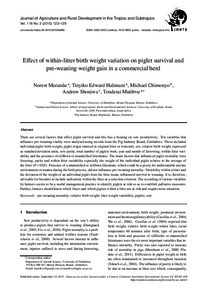Aufsatz

Effect of within-litter birth weight variation on piglet survival and pre-weaning weight gain in a commercial herd
Zusammenfassung
There are several factors that affect piglet survival and this has a bearing on sow productivity. Ten variables that influence pre-weaning vitality were analysed using records from the Pig Industry Board, Zimbabwe. These included individual piglet birth weight, piglet origin (nursed in original litter or fostered), sex, relative birth weight expressed as standard deviation units, sow parity, total number of piglets born, year and month of farrowing, within-litter variability and the presence of stillborn or mummified littermates. The main factors that influenced piglet mortality were fostering, parity and within-litter variability especially the weight of the individual piglet relative to the average of the litter (P<0.05). Presence of a mummified or stillborn littermate, which could be a proxy for unfavourable uterine environment or trauma during the birth process, did not influence pre-weaning mortality. Variability within a litter and the deviation of the weight of an individual piglet from the litter mean, influenced survival to weaning. It is, therefore, advisable for breeders to include uniformity within the litter as a selection criterion. The recording of various variables by farmers seems to be a useful management practice to identify piglets at risk so as to establish palliative measures. Further, farmers should know which litters and which piglets within a litter are at risk and require more attention.
Zitierform
In: Journal of Agriculture and Rural Development in the Tropics and Subtropics. Kassel : Kassel University Press. - Vol. 116, No. 2 (2015), S. 123-129Sammlung(en)
Vol 116, No 2 (2015) (Journal of Agriculture and Rural Development in the Tropics and Subtropics (JARTS))Zitieren
@article{urn:nbn:de:hebis:34-2015061048480,
author={Marandu, Norest and Halimani, Tinyiko Edward and Chimonyo, Michael and Shoniwa, Andrew and Mutibvu, Tonderai},
title={Effect of within-litter birth weight variation on piglet survival and pre-weaning weight gain in a commercial herd},
year={2015}
}
0500 Oax 0501 Text $btxt$2rdacontent 0502 Computermedien $bc$2rdacarrier 1100 2015$n2015 1500 1/eng 2050 ##0##urn:nbn:de:hebis:34-2015061048480 3000 Marandu, Norest 3010 Halimani, Tinyiko Edward 3010 Chimonyo, Michael 3010 Shoniwa, Andrew 3010 Mutibvu, Tonderai 4000 Effect of within-litter birth weight variation on piglet survival and pre-weaning weight gain in a commercial herd / Marandu, Norest 4030 4060 Online-Ressource 4085 ##0##=u http://nbn-resolving.de/urn:nbn:de:hebis:34-2015061048480=x R 4204 \$dAufsatz 4170 7136 ##0##urn:nbn:de:hebis:34-2015061048480
<resource xsi:schemaLocation="http://datacite.org/schema/kernel-2.2 http://schema.datacite.org/meta/kernel-2.2/metadata.xsd"> 2015-09-29T08:51:49Z 2015-09-29T08:51:49Z 2015-09-15 1612-9830 2363-6033 urn:nbn:de:hebis:34-2015061048480 http://hdl.handle.net/123456789/2015061048480 eng Kassel University Press Urheberrechtlich geschützt https://rightsstatements.org/page/InC/1.0/ pre-weaning mortality relative birth weight litter weight variability piglets sow 630 Effect of within-litter birth weight variation on piglet survival and pre-weaning weight gain in a commercial herd Aufsatz There are several factors that affect piglet survival and this has a bearing on sow productivity. Ten variables that influence pre-weaning vitality were analysed using records from the Pig Industry Board, Zimbabwe. These included individual piglet birth weight, piglet origin (nursed in original litter or fostered), sex, relative birth weight expressed as standard deviation units, sow parity, total number of piglets born, year and month of farrowing, within-litter variability and the presence of stillborn or mummified littermates. The main factors that influenced piglet mortality were fostering, parity and within-litter variability especially the weight of the individual piglet relative to the average of the litter (P<0.05). Presence of a mummified or stillborn littermate, which could be a proxy for unfavourable uterine environment or trauma during the birth process, did not influence pre-weaning mortality. Variability within a litter and the deviation of the weight of an individual piglet from the litter mean, influenced survival to weaning. It is, therefore, advisable for breeders to include uniformity within the litter as a selection criterion. The recording of various variables by farmers seems to be a useful management practice to identify piglets at risk so as to establish palliative measures. Further, farmers should know which litters and which piglets within a litter are at risk and require more attention. open access In: Journal of Agriculture and Rural Development in the Tropics and Subtropics. Kassel : Kassel University Press. - Vol. 116, No. 2 (2015), S. 123-129 Marandu, Norest Halimani, Tinyiko Edward Chimonyo, Michael Shoniwa, Andrew Mutibvu, Tonderai Gedruckte Ausg. im Verlag Kassel Univ. Press (www.upress.uni-kassel.de) erschienen. </resource>
Die folgenden Lizenzbestimmungen sind mit dieser Ressource verbunden:
Urheberrechtlich geschützt

